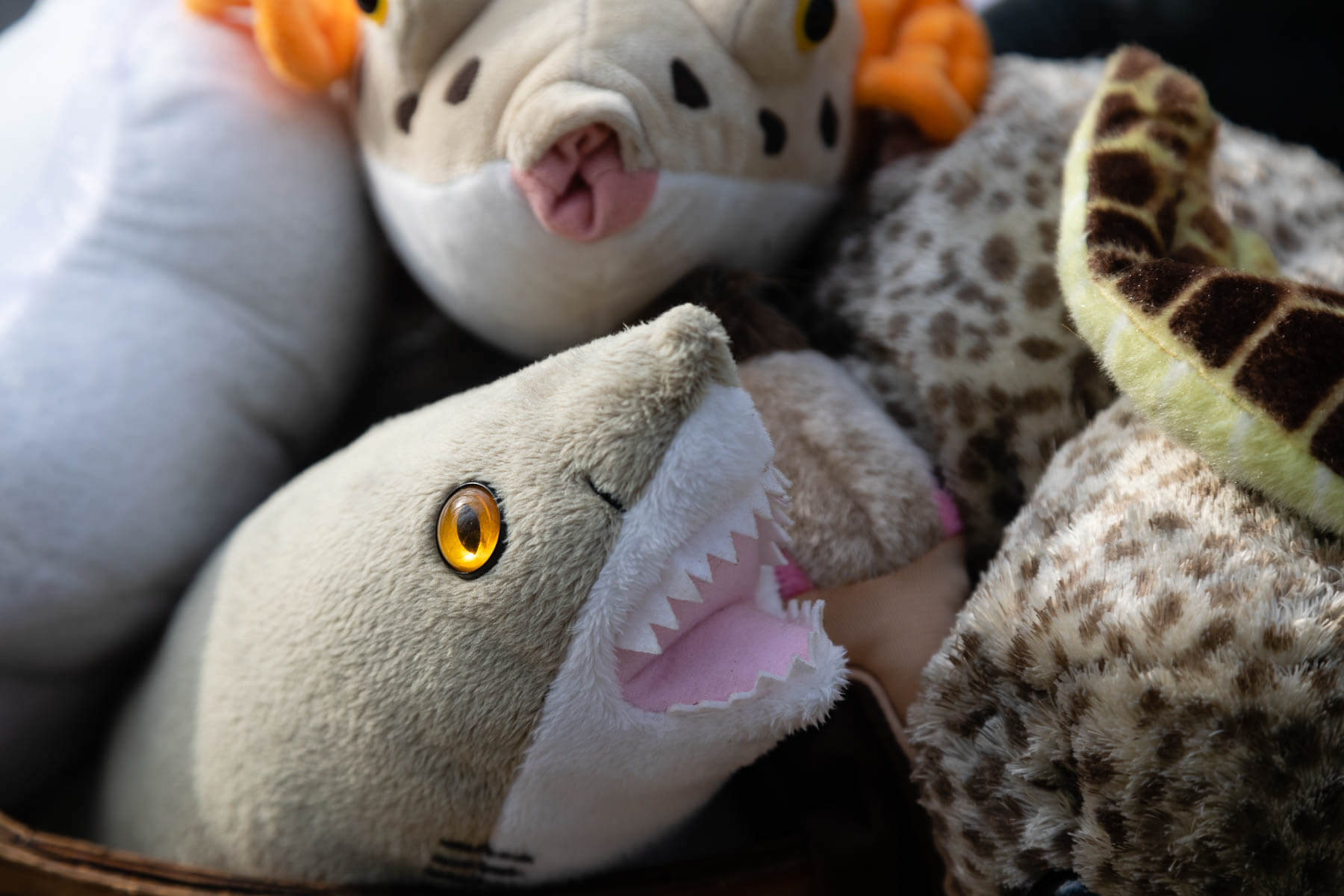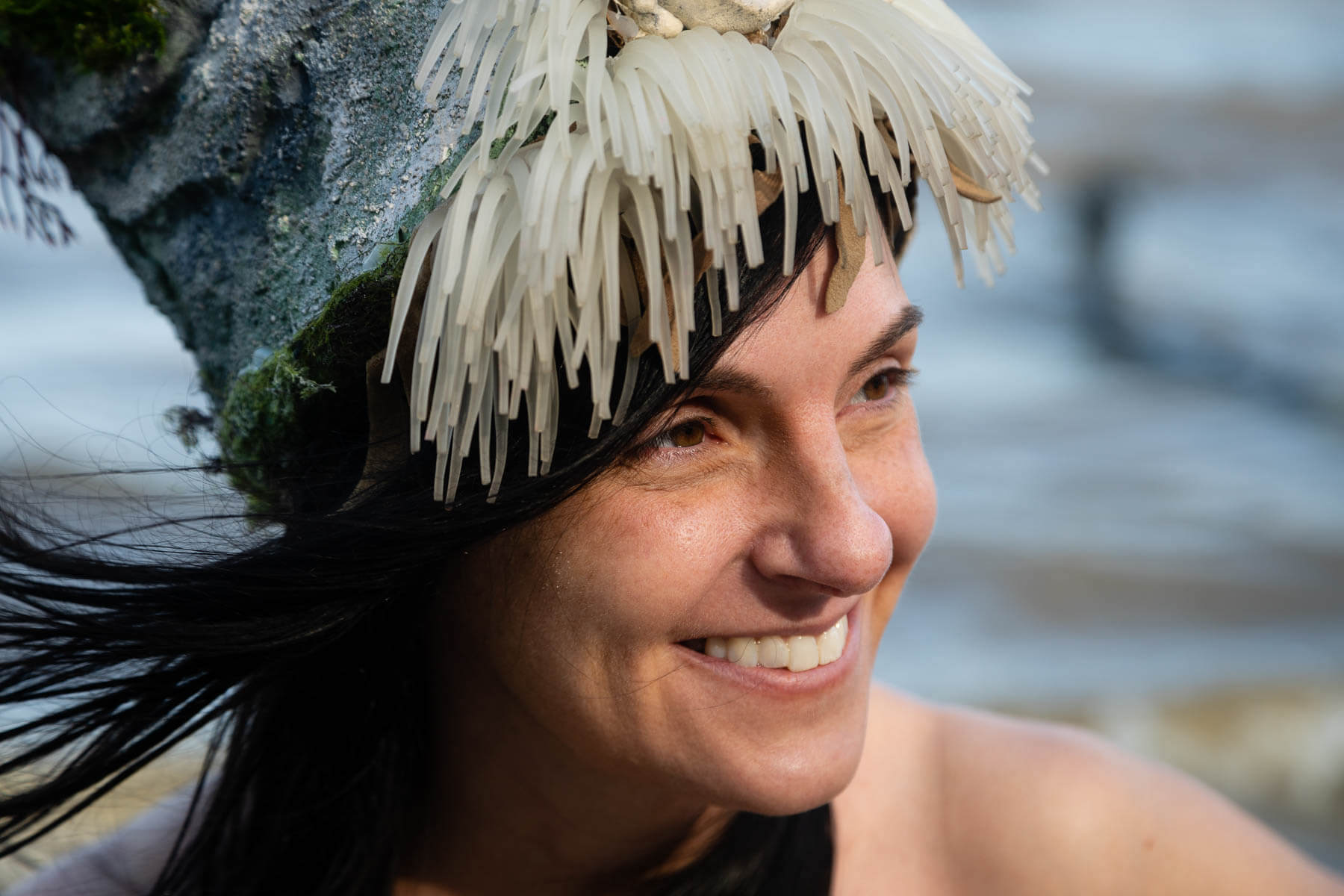An interview with a mermaid

The Chesapeake Mermaid may surprise you when you first meet her. Her scales are a gradient of goldish-yellow fading to purple-blue and her tail resembles the shortnose sturgeon. When I saw her for the first time, she was sitting perched on a fallen tree at Bayfront Park in Chesapeake Beach, Maryland.
“I’m not a pretty princess mermaid covered in glitter,” she said. “In fact, most of the time I’m doing the kids’ shows, I’m covered in dirt and sweat and I’ve got scratches from the animals that I’ve been caring for.”
The mermaid has always been a volunteer, helping out with wildlife and conservation. In 2010, she decided to start a blog where she would post about wildlife, habitats and volunteering—along with the occasional photo of her in the water.
“It was really a call to action, like, ‘Look how fun these things are that I’m doing. Come out and join me.’”
But her readers wanted to meet her and at the same time, she realized that the blog wasn’t effective enough outreach.
“I wanted to go off and do something entirely different. Maybe even a little crazy. Incredibly creative. Just really put my tail on display for the sake of the Bay.”
So, the Chesapeake Mermaid got out of the water and did her first event on land in 2016. Since then, she has built up a whole educational experience for her audience of mainly children. She brings her Bay home on land, but with a twist: she sits on an oyster reef made of recycled newspapers. Her lessons consist of songs, maps, stories and her animal friends—all within reach, since she can’t just get up and walk around.
“I got a lot of weird looks when I first started,” she remembered.
But the kids, she stressed, love it. “I’ll say, ‘”Chesapeake.” That’s a really big word, isn’t it? What does that mean?’ and kids will raise their hand and with confidence say, ‘It’s a restaurant,’ ‘It’s a hotel.’” And it’s fun to laugh but I think it’s really important that these kids understand that Chesapeake is more than that. It’s our connection to the Bay. It’s our heritage. It’s our culture.”

The truth, wrapped in a story
For the Chesapeake Mermaid, storytelling is the best way to engage kids with wildlife and the environment.
“I try to put the truth out there wrapped up in a story,” she said. “A mermaid is a great introduction because I’m half human, half fish. I’m reminding everyone that even if we think we know everything, we still may only know half the story.”
On top of that, she has firsthand experience with conservation work. “I like to think that my particular style of education is different in that I’m doing it,” she said. “I’m giving people firsthand accounts of the wildlife and the habitats I’ve helped rebuild.”
The Chesapeake Mermaid is active in restoration activities, including rebuilding oyster reefs and rehabilitating wildlife. When she attended volunteer events, she would hear from adults that they wished they could stay longer and do more, but they had to get home to their kids. She realized that there was an opportunity to link her events with volunteer opportunities.
However, she felt that there weren’t any resources that she thought were appropriate to engage the young kids with the topics that the adults were volunteering with, such as oyster reef restoration. So she decided to make her own.
She published her first book, The Last Bivalvian, in 2017 to educate and entertain kids with a topic that their parents were working with hands on. The Last Bivalvian introduces the Chesapeake Mermaid’s friend, Larvey, the last of the magical Bivalvians, a mythical ancestor of oysters. Through this story, she teaches kids about oysters, their importance to the Bay and how kids can help oysters.
She followed up this story with a second one two years later, focusing on the impacts of development, called The Giants of the Bay.

Telling a new story
The Chesapeake Mermaid has a new way of storytelling as well, through sign language. After a day swimming in the Choptank River, she started having some issues. Some of her friends had bacterial infections, but she didn’t make the connection until, she recalled, “I went to bed one night and when I woke up, I was deaf!”
She doesn’t know exactly what happened—by the time she got to a doctor, any bacterial infection she could have had was gone. “But I think it’s very highly suspect that it’s from the water.”
Swimming in the waters of the Bay won’t make everyone deaf; however, there are several different varieties of contaminants that flow into the Bay that can cause illness. You can do your part to help keep the Bay clean by cleaning up after your pet to reduce the amount of E. coli and pollution-causing nutrients that enter our water
Remaining hopeful, she used her new deaf world in the same way she used her volunteer work—as an invitation to others to learn and explore along with her. There is much to learn, and the adjustment can take years, but she does her best to remain optimistic. “I have my share of tears at night over the whole thing,” she admitted.
But she doesn’t discourage people from going in the water. In fact, it seems to propel her even further.
“I don’t necessarily want to scare people away because part of what I’m trying to do is get people interested in how wonderful all of this is.”
She’s even changed her show. “I’m incorporating some signs and more of my world, which right now has been half hearing and half deaf. So that’s kind of right up my alley with being half human and half fish.”
What it takes to be a mermaid
The future well-being of the Chesapeake Bay watershed will soon rest in the hands of its youngest residents—more than three million students in kindergarten through 12th grade. Establishing strong, targeted environmental education programs now provides a vital foundation for these future watershed stewards. In the Chesapeake Bay Watershed Agreement our partnership committed to three environmental literacy outcomes so that students can graduate with the knowledge and skills to act responsibly to protect and restore their local watershed.
The mermaid noted schools are working to better integrate environmental education into their lessons. “They’re getting more and more of them into schools and so kids are getting to see them more too themselves.” Teachers and Scout leaders reach out to her, asking where they can volunteer, so she points them to local environmental groups.
Inevitably at her events, a child will ask if she truly is a mermaid. Here is what she tells them:
“I’m working on the Bay. I live with animals. I swim in the Chesapeake Bay. And I’m here exploring and educating and finding out new things with you. That’s what it takes to be a mermaid, right?”
And their response? “Yeah!”
But she stressed, “It’s not so much about trying to get people to believe in mermaids. A lot of times I’ll tell the kids, ‘It’s ok if you don’t believe in mermaids, but I believe in you.’”
The Chesapeake Mermaid’s goal is really to create connections between people, between land and water, between our actions and the world around us.
“I want people to feel like part of the solution.”
Check out our How-To’s and Tips page for ways you can be part of the solution.

Comments
There are no comments.
Thank you!
Your comment has been received. Before it can be published, the comment will be reviewed by our team to ensure it adheres with our rules of engagement.
Back to recent stories